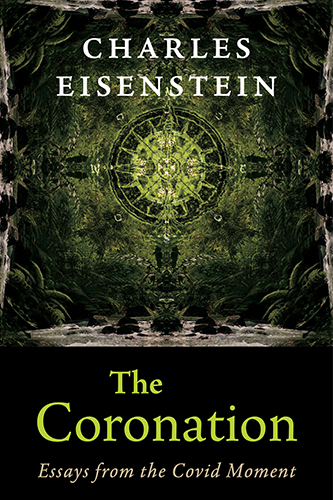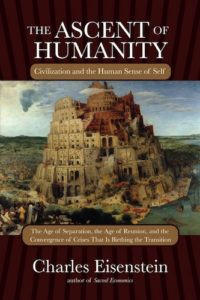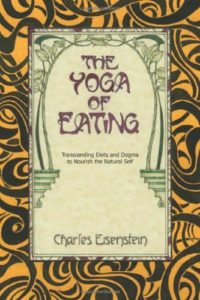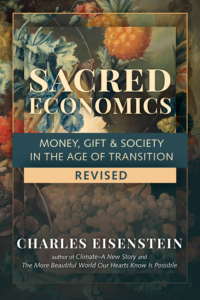The More Beautiful World Our Hearts Know Is Possible
Chapters
Chapter 19: Doing
All of these flavors of scarcity share a common root, a kind of existential scarcity for which I cannot find a name. It is a scarcity of being, the feeling “I am not enough” or “There is not enough life.” Born of the cutoff of our extended selves that inter-exist with the rest of the universe, it never lets us rest. It is a consequence of our alienation, our abandonment to a dead, purposeless universe of force and mass, a universe in which we can never feel at home, a universe in which we are never held by an intelligence greater than our own, never part of an unfolding purpose. Even more than the scarcity of time or money, it is this existential unease that drives the will to consume and control.
The primary habit that arises from it is the habit of always doing. Here and now is never enough. You might protest that most people in the Western world spend vast amounts of time doing nothing productive at all, watching TV and playing video games, but these are displacements of doing, and not nondoing.
I am not saying that it is bad to do. I am saying that there is a time to do, and a time not to do, and that when we are slave to the habit of doing we are unable to distinguish between them. As I mentioned earlier, the time to do is when you know what to do. When you don’t know what to do, and act anyway, you are probably acting out of habit.
Let’s not get too caught up in the word “do”—obviously, the distinction between doing and not doing breaks down under close scrutiny. Perhaps an example will make my meaning clearer. I recently participated in a daylong meeting of about thirty activists from around the world, gathered around the issue of localism. We’d all been speakers at a conference. The day started with a conversation that, after an hour or two, started to touch on some deep issues of how to create change. But then some of us were uncomfortable with what we perceived as “just talking” (or was it that we were uncomfortable with the deeper things we were touching?), so we split up into task-centered groups to “do something.” Part of our group consciousness believed that if we didn’t produce an action plan, a statement, or something tangible from the day, it would have been a waste. As it turned out, it was the afternoon that felt like the waste, and the morning that felt productive—despite the fact that nothing got “done.” Perhaps the problem was that we had rushed into an attempt to “do” before the group as an entity was mature. We acted from a habit of urgency. Again, that is not to say we should never make plans, organize task groups, delegate work, or engage in linear, step-by-step thinking. It is that we need to acquire sensitivity to when it is the right time to do these things.
We are like a man lost in a maze. He runs around frantically, hitting the same dead ends again and again, repeatedly circling back to his starting point. Finally he pauses to rest, to breath, to ponder. Then in a flash he understands the logic of the maze. Now it is time to begin walking. Imagine if instead he says, “No, I cannot pause to rest. Only by moving my feet will I ever get anywhere. So I must not stop moving my feet.” We tend to devalue those periods of pause, emptiness, silence, and integration.
How to get out of a maze? Yes, it does help to wander around and explore, but at some point one must stop and reflect. Is there a pattern to my wanderings? What do I remember about how I got lost here in the first place? What is this maze for, anyway? Perhaps the earlier stage of panicked, frantic running around, or of increasingly futile action, is necessary, but many of us are now ready to try another way.
The situation on Earth today is too dire for us to act from habit—to reenact again and again the same kinds of solutions that brought us to our present extremity. Where does the wisdom to act in entirely new ways come from? It comes from nowhere, from the void; it comes from inaction. When we see it, we realize it was right in front of us all along. It is never far away; yet at the same time it is in a different universe—a different Story of the World. A Chinese saying describes it well: “As far away as the horizon, and right in front of your face.” You can run toward it forever, run faster and faster, and never get any closer. Only when you stop do you realize you are already there. That is exactly our collective situation right now. All of the solutions to the global crisis are sitting right in front of us, but they are invisible to our collective seeing, existing, as it were, in a different universe.
When we are trapped in a story, we can only do the things that that story can recognize. Often we are aware of being trapped (the old story is ending) but don’t have access to any alternative (we haven’t yet inhabited a new story). Leaders in social and environmental organizations feel trapped in the confines of the fund-raiser, the membership campaign, the press release, and the white paper. A new outrage looms. What to do? Send out another appeal? On every level, our solutions are less and less effectual, but our story allows no alternative.
The same might be said for the monetary authorities’ response to financial crisis, and more generally to governments everywhere. In most places, the political system is frozen into increasingly irrelevant debates, in which real solutions aren’t even on the table. In the U.S., amid the wrangling over troop levels, withdrawal timetables, and so on, where is the call to withdraw from all military bases worldwide and dismantle the standing army entirely? It is not part of the conversation. Of course, for it to enter the conversation would require the rejection of deeply held myths about the way the world works, the causes of war and terrorism, the real goals of American foreign policy, and so on, all the way down to our notions of good and evil. If one has not questioned these myths, then a call to disband the military would seem laughably naive.
Similarly, where in the universe of political dialogue on agricultural policy is the idea of a large-scale transition to permaculture, involving big gardens where lawns are today, a repopulation of rural land, humanure composting, and the therapeutic benefits of reconnecting to the soil? This could sequester carbon back into the soil, end the eutrophication of waterways, replenish aquifers, and reverse desertification. It would provide meaningful work to millions who are looking for it, drastically reduce fossil fuel use—and produce more food on less land, allowing wild ecosystem restoration.
It takes some doing to document these claims. Many authorities state categorically, “The only way to feed seven billion people on this planet is with massive fossil fuel inputs.” To refute this claim requires deconstructing its basic assumptions about agriculture and diet. How many of them take into account (to use one example of hundreds) crops like the Mayan bread nut, which in the tropics can produce eight times the caloric yield of corn per hectare with superior nutrition and storability, can be collected in vast quantities with minimal labor, requires no pesticides, only needs to be planted once, is drought-resistant, provides fodder for goats and cows, and can be used as an overstory crop with vegetables, aquaculture, etc., underneath? This tree has been cut down all over Central America to make room for corn.
Clearly, a transition to crops like Mayan bread nuts and hundreds of other underutilized food species cannot happen without accompanying cultural and economic changes. The globalization of food culture, media images that perpetrate an industrial diet, the cultural narrative that holds agricultural work as lowly, the financial system that pushes farmers toward commodity crop production, regulations that take existing agricultural practices for granted, and the pecuniary interests of seed and pesticide companies all contribute to the agricultural status quo. The very notion of a uniform crop growing on a controlled substrate draws from scientific paradigms of a generic material substrate of uniform elements upon which we impose order and design.
That’s a lot of stories, layer upon layer, that have to change. Thus I say that our revolution must go all the way to the bottom, all the way down to our basic understanding of self and world. We will not survive as a species through more of the same: better breeds of corn, better pesticides, the extension of control to the genetic and molecular level. We need to enter a fundamentally different story. That is why an activist will inevitably find herself working on the level of story. She will find that in addition to addressing immediate needs, even the most practical, hands-on actions are telling a story. They come from and contribute to a new Story of the World.
Endnotes:
16. Except of course on the fringes. It is not, as far as I know, one of the options that those in government are talking about.
17. I have chosen here an example that conflicts with current paradigms only mildly. I could also discuss Schauberger-inspired water practices, homeopathic soil preparations, the methods used at Findhorn, or Machaelle Small Wright’s work with nature devas. But then, those of you who are prepared to accept Mayan bread nuts but not water intelligence or nature devas might doubt the rest of what I have to say too—guilt by association. Now now, I don’t really believe in those things, do I? Joking aside, the truth is that I would like to believe them, but still need help to effectively inhabit those stories. When I tried supplicating the nature devas, a groundhog ate every vegetable in my garden anyway.






